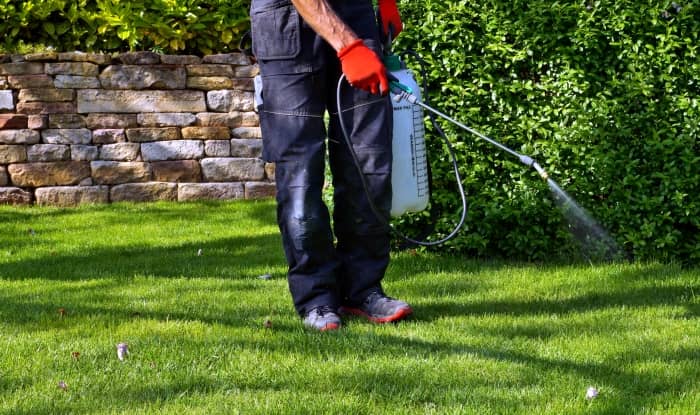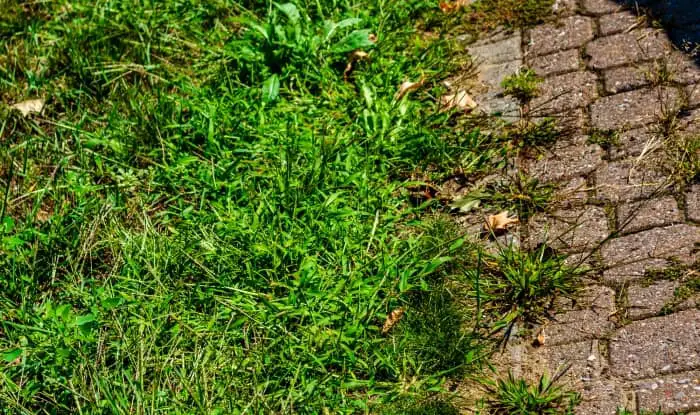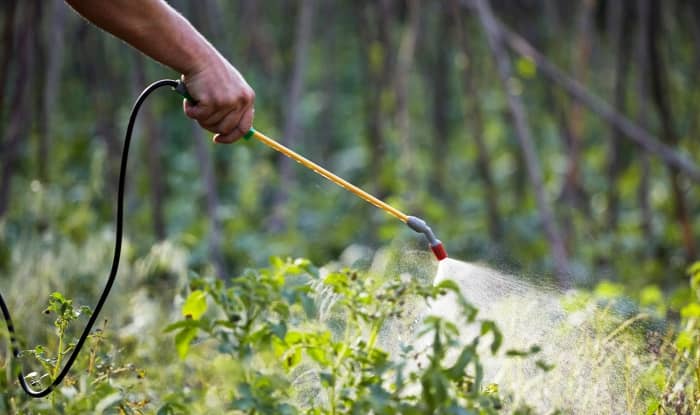Weeds are a constant battle for gardeners. It’s important to kill weeds as they appear, or they can quickly take over and turn your lawn and garden into an untidy mess. Weeds also prevent grass and desirable plants from getting the water and nutrients they need to grow in good health.
You can use pre-emergent weed control to prevent weeds from sprouting. But, for weeds that manage to find their way through the topsoil, you need to use a post-emergent herbicide.
So in this article, I’ll show you when to apply post-emergent herbicide. And how to apply it to get the best results.
Let’s dive in.
How Post-emergent Herbicides Work
Post-emergent herbicides kill weeds that are currently growing above ground. But unless they have residual activity, they won’t prevent weed seeds from developing after germination. For that, you need a pre-emergent herbicide.
Post-emergent herbicides come in different types that work slightly differently. Understanding how each type works will help you make the right choice for your situation and set the right expectations for what you are likely to achieve.
Selective Herbicides
Selective herbicides only target specific types of weeds. Usually, they kill broadleaf weeds and certain types of grassy weeds. Selective herbicides are often used on lawns because a broadleaf herbicide won’t harm most common types of turfgrass.
But not all selective herbicides are safe to use on all types of turfgrass. So check the label and make sure the herbicide is safe to use on your lawn.
Non-selective Herbicides
Non-selective herbicides kill all plants. You don’t want to use this type of herbicide on your lawn. And you have to be very careful when using it around desirable plants in your yard.
Non-selective herbicides are a good choice when you’re spraying areas where you don’t want anything to grow, such as the cracks between patio pavers, sidewalks, and driveways, as well as gravel. And non-selective herbicides are ideal for treating large infested areas of weeds where you want to kill everything and start again.
Systemic Herbicides
Weeds absorb systemic herbicides through the foliage. Once inside the plant, the herbicide is translocated to all parts, killing the weed from the inside. Because systemic herbicides kill the roots, the weed cannot grow back.
But because systemic herbicides travel slowly through the circulatory system, it often takes two or three weeks for the plant to die. Most selective herbicides are also systemic herbicides.
Contact Herbicides
Contact herbicides target the part of the weed that’s growing above ground, killing the leaves and sometimes the stalks and stopping the plant from photosynthesizing.
But because the herbicide doesn’t kill the plant roots, the weed can sometimes grow back. And you need to apply the herbicide repeatedly until the root system exhausts itself.
Contact herbicides give faster results than systemic herbicides because they work immediately after application. Most contact herbicides are also non-selective herbicides.
When To Apply Post-emergent Herbicides
Although you can apply post-emergent herbicides whenever you see weeds in your yard, certain times of year and times of day tend to be the most effective.
Time Of Year
One of the best times of the year to apply post-emergent herbicide is in late spring when the weeds are actively growing but are still small. It’s easier to kill young weeds.
Weeds that are growing are also more likely to translocate the herbicide around the entire weed, killing all parts of the plant, including the roots.
You can continue to use post-emergent herbicides throughout the summer as some weeds require multiple applications to get them under control.
Because weeds need to be actively growing for systemic herbicides to work, you should wait until the soil temperature has reached 55° F. Even when treating cool-season weeds such as Henbit and chickweed.
Another good time to apply post-emergent herbicides is in the fall. This is a particularly good time to kill perennial weeds because the plants are translocating carbohydrates to the roots and rhizomes. So systemic herbicides will be carried in greater quantity to these parts of the weed.
It’s also worth noting that herbicide is less effective against weeds that are experiencing drought and disease. When the weeds are under stress, they’re less likely to absorb and translocate the herbicide.
Time Of Day
Weeds grow fastest in the morning, with the growth rate slowing in the afternoon and evening. So you want to spray the weeds with post-emergent weed killer in the morning.
Don’t apply the herbicide if the temperature is above 85° F. If the temperature is too high, the herbicide might burn your lawn.
It’s a good idea to check the weather forecast. Rain can wash away and dilute the effects of the herbicide. So it’s best to apply the herbicide on a clear day. If you think it might rain, make sure you have enough time for your product to be rainfast.
Try to avoid windy days. The wind can cause the herbicide to drift onto desirable plants that you don’t want to spray. And it makes it harder to get even coverage of the treated area.
How to apply post-emergent herbicides
You can apply post-emergent herbicides in two ways, broadcast application or spot treatment.
Broadcast Application
It’s best to use a broadcast application when the area you’re treating is heavily-infested with weeds. In this situation, spot treatment takes a long time. And it’s easier to use a blanket approach.
If you’re using a liquid post-emergent, you’ll need to mix it with water and apply it using a herbicide sprayer. If you’re using weed killer granules, then you’ll need a spreader.
Walk up and down the area applying the weed killer evenly across the treated area. Some gardeners like to add spray indicator dye to the liquid weed killer. This makes already sprayed areas visible and ensures they haven’t missed any patches. With granular herbicide, you can usually see where you’ve applied the granules and go back and fill in any gaps.
Spot Treatment
Spot treatment focuses on individual weed plants that are growing in the area. A handheld sprayer is often sufficient to do the job. If using a non-selective weed killer, be careful not to damage nearby plants and grass. If necessary, use cardboard to protect the plants as you spray.
FAQ
What temperature should I apply post-emergent?
Post-emergent herbicides work best when the temperature is between 65° F to 85° F. Weed growth slows down below 60° F and systemic herbicides are less likely to be effective.
How often can you spray post-emergent?
You can spray post-emergent herbicide every 10-14 days. Remember that systemic herbicides can take 2-3 weeks to kill weeds. So it’s worth waiting until you’re sure the weed hasn’t died before applying the herbicide again.
Should I mow before applying post-emergent?
Avoid mowing your lawn for at least 3 days before applying post-emergent herbicide and 3 days after. This leaves plenty of foliage on the plant to absorb the weed killer. And allows time for the herbicide to travel out of the leaves and into the circulatory system of the plant.
How long to wait after post-emergent before I seed?
If you want to seed, the length of time you have to wait varies depending on the post-emergent you use. But you often have to wait 2-4 weeks before you can seed. Be careful with the product you choose. Some non-selective post-emergent herbicides have a residual activity that prevents seedlings from developing for up to a year.



